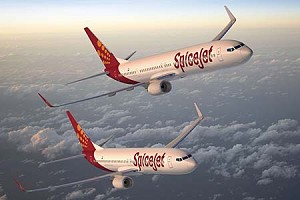

with low cost carriers a dime a dozen,the traveller has truly become the king.referred to as udipi restaurants of the aviation industry by captain gopinath of air deccan,there is going to be a lot of dogfight up in the air.
civil avaition minster,praful patel, has recently said that domestic air passenger traffic will grow at 50% per annum and international travel at 25% per annum.indigo,a low cost carrier, had placed orders for 100 airbuses(A 320),during last year's aviation show in paris.these are phenomenal growth rates and massive investments will have to be made in the infrastructure to cope up with the increased air traffic.the good news is that more of our airports are getting upgraded,and private capital is being brought in to quickly and efficiently cater to this boom.the bad news is that with a scorching growth rate like this, it may just not be enough.number of tourists visiting india has also shown an increasing trend and it augurs well for the low cost airline industry.
besides the major trunk routes,the low cost airlines are having services between smaller towns e.g. coiambatore/madurai/trichy etc. air travel has become affordable which was hitherto unthinkable.
the low cost airlines are airlines which cut out the frills and ply their aeroplanes on a bare-bones basis with the objective of safely and economically carrying passengers from one destination to another.there are different business models for these carriers being practised.single passenger class(no business class),same type of aircraft(reduction of inventory of spares and maintenance costs),simple fare scheme(fare goes up as the aircraft fills up and nearer the day of travel),unreserved seating (encouraging air travellers to board the flight early),early morning and evening flights and quicker turnaround times(reduced airport landing and other charges),sale of tickets over the internet to reduce agency commission costs,employees performing multiroles as i saw on air deccan,paid for in-flight(food and drinks add to the revenue) and bold fuel-hedging programmes. most of our domestic low cost carriers build in in their business models most of the above cost reduction steps to keep a healthy bottomline.
inspite of many of these cost reduction measures, air deccan has racked up losses and lost about rs 6oo crores so far.and for sure other lc airlines are also bleeding.but then,if they have the right model and are able to gather critical mass interms of passenger load factor they have a pretty good chance of reducing the high cash-burn and lower yields.they then have a good chance of getting into the black and remaining there for long and reap the benefits. but then with new players jumping into the fray, the airline that will win will be one that has a reliable on-time performance,good and competent people at all levels,and one that uses modern technology across the board.
by making flying affordable for the common man,these airlines are developing the market.also with rising expendable income,lifestyle changes are taking place.travelling by train is time consuming.therefore there is a preference for air travel.it is no more a luxury but a necessity.more children,senior citizens and tourists are taking to the air.
some of the these airlines have started charter services,helicopter on demand and their own cargo arm.to tap the air cargo business.jet airways,kingfisher and goair have all announced their plans of starting their own cargo extensions.
surprisingly, there is a lowcost aircarrier which has turned the conventional business model upsidedown on its head.our low cost carriers can learn a few lessons from shaheed k abbasi of pakistan's airblue.in what way is it different from other low cost airliners? it serves piping hot meals on all its flights,has dual class seating arrangements,sells tickets at 40% discount to full service carriers(fsc) and as the date of travel comes closer, the fare may have gone up 30% over the price charged by the fscs.airblue has zero debt on its books and all initial fleet expansion will be funded by internal accruals.it has one third of the marketshare in pakistan in three years after commencement.abassi believes that "you need a happy customer and not just a price conscious one.people associate travelling with hot meals and we realised that serving food was necessary".abbassi has applied to fly to india. if the visa and other issues are sorted out,he sees scope for 20 flights a day between india and pakistan.
the fscs are not just sitting and sucking their thumbs.low cost carriers are a serious threat to their profitability and future viability.most of them have launched frequent flyer programmes,and other loyalty programmes to keep their customers in their flock.discounted fares are also available on these airlines as well.on some days on certain routes you might find them even cheaper than the low cost carriers.there is going to be a free for all among the lccs and the fscs.ultimately it is the customer who will be the king.

No comments:
Post a Comment